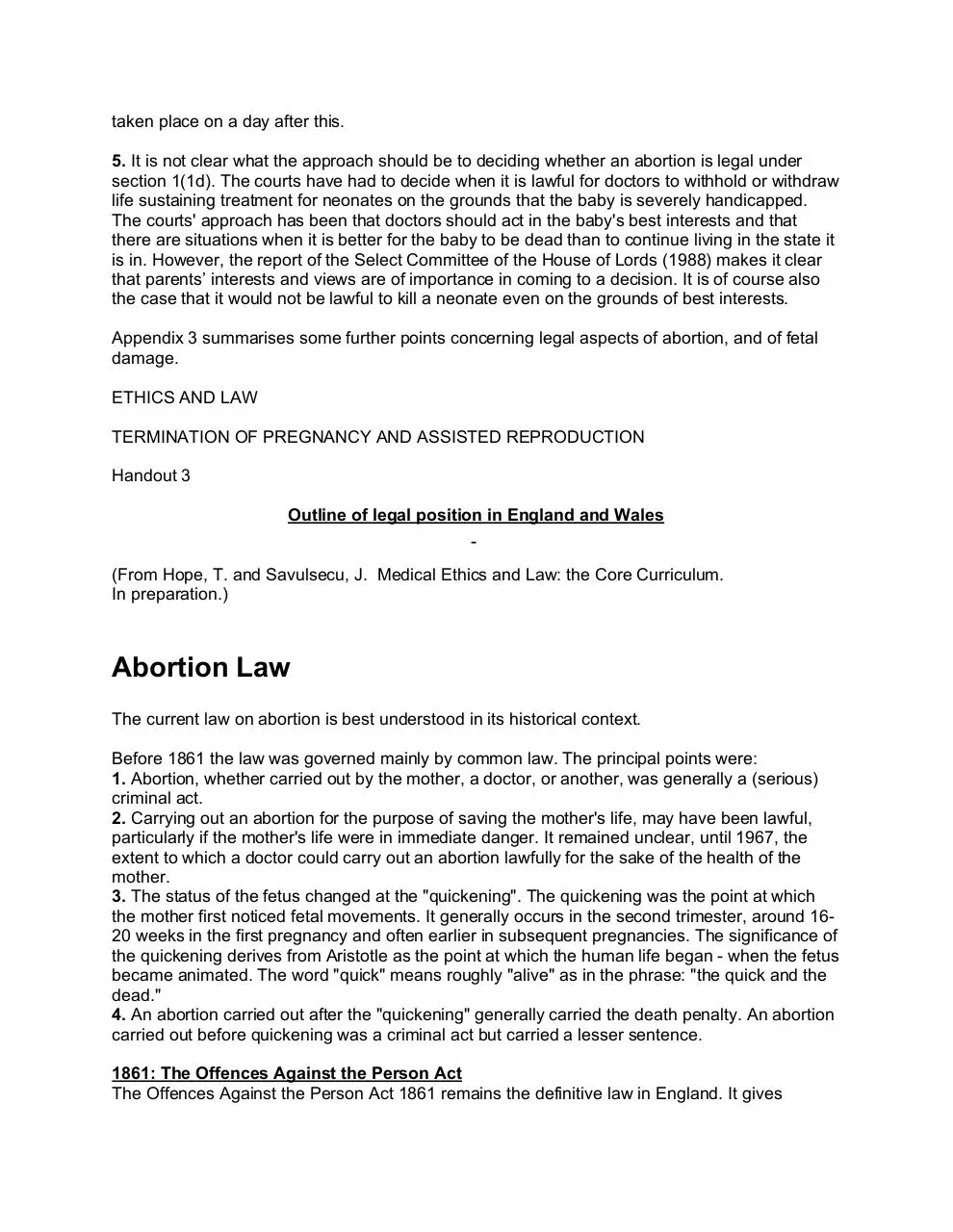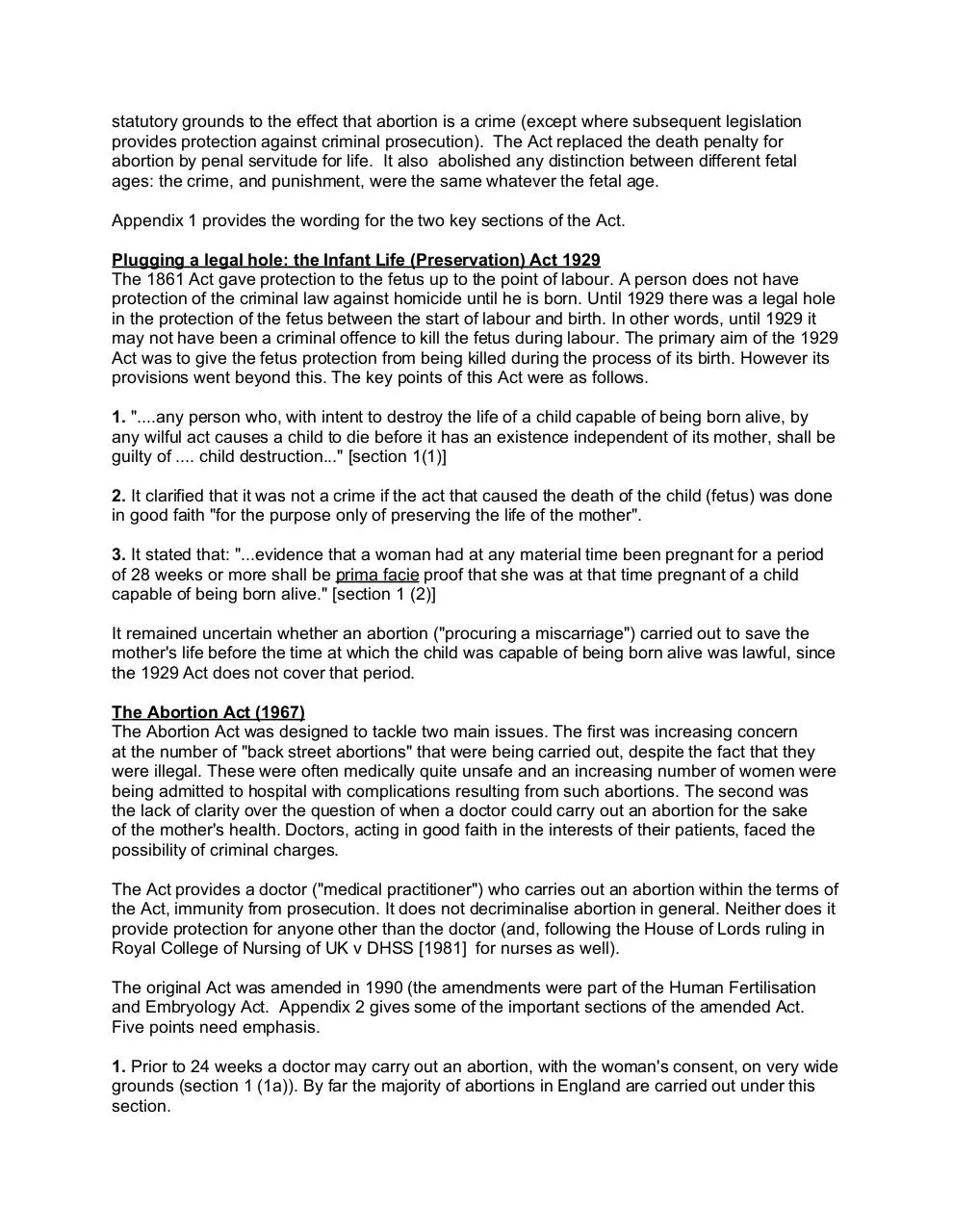termination of pregnancy handout (PDF)
File information
This PDF 1.4 document has been generated by Documill Publishor 6.3.10.1 by Documill (http://www.documill.com/) / iText 2.1.6 by 1T3XT, and has been sent on pdf-archive.com on 29/05/2012 at 22:29, from IP address 173.163.x.x.
The current document download page has been viewed 1448 times.
File size: 72.03 KB (5 pages).
Privacy: public file





File preview
ETHICS AND LAW
TERMINATION OF PREGNANCY AND ASSISTED REPRODUCTION
Handout 3
Outline of legal position in England and Wales
(From Hope, T. and Savulsecu, J. Medical Ethics and Law: the Core Curriculum.
In preparation.)
Abortion Law
The current law on abortion is best understood in its historical context.
Before 1861 the law was governed mainly by common law. The principal points were:
1. Abortion, whether carried out by the mother, a doctor, or another, was generally a (serious)
criminal act.
2. Carrying out an abortion for the purpose of saving the mother's life, may have been lawful,
particularly if the mother's life were in immediate danger. It remained unclear, until 1967, the
extent to which a doctor could carry out an abortion lawfully for the sake of the health of the
mother.
3. The status of the fetus changed at the "quickening". The quickening was the point at which
the mother first noticed fetal movements. It generally occurs in the second trimester, around 1620 weeks in the first pregnancy and often earlier in subsequent pregnancies. The significance of
the quickening derives from Aristotle as the point at which the human life began - when the fetus
became animated. The word "quick" means roughly "alive" as in the phrase: "the quick and the
dead."
4. An abortion carried out after the "quickening" generally carried the death penalty. An abortion
carried out before quickening was a criminal act but carried a lesser sentence.
1861: The Offences Against the Person Act
The Offences Against the Person Act 1861 remains the definitive law in England. It gives
statutory grounds to the effect that abortion is a crime (except where subsequent legislation
provides protection against criminal prosecution). The Act replaced the death penalty for
abortion by penal servitude for life. It also abolished any distinction between different fetal
ages: the crime, and punishment, were the same whatever the fetal age.
Appendix 1 provides the wording for the two key sections of the Act.
Plugging a legal hole: the Infant Life (Preservation) Act 1929
The 1861 Act gave protection to the fetus up to the point of labour. A person does not have
protection of the criminal law against homicide until he is born. Until 1929 there was a legal hole
in the protection of the fetus between the start of labour and birth. In other words, until 1929 it
may not have been a criminal offence to kill the fetus during labour. The primary aim of the 1929
Act was to give the fetus protection from being killed during the process of its birth. However its
provisions went beyond this. The key points of this Act were as follows.
1. "....any person who, with intent to destroy the life of a child capable of being born alive, by
any wilful act causes a child to die before it has an existence independent of its mother, shall be
guilty of .... child destruction..." [section 1(1)]
2. It clarified that it was not a crime if the act that caused the death of the child (fetus) was done
in good faith "for the purpose only of preserving the life of the mother".
3. It stated that: "...evidence that a woman had at any material time been pregnant for a period
of 28 weeks or more shall be prima facie proof that she was at that time pregnant of a child
capable of being born alive." [section 1 (2)]
It remained uncertain whether an abortion ("procuring a miscarriage") carried out to save the
mother's life before the time at which the child was capable of being born alive was lawful, since
the 1929 Act does not cover that period.
The Abortion Act (1967)
The Abortion Act was designed to tackle two main issues. The first was increasing concern
at the number of "back street abortions" that were being carried out, despite the fact that they
were illegal. These were often medically quite unsafe and an increasing number of women were
being admitted to hospital with complications resulting from such abortions. The second was
the lack of clarity over the question of when a doctor could carry out an abortion for the sake
of the mother's health. Doctors, acting in good faith in the interests of their patients, faced the
possibility of criminal charges.
The Act provides a doctor ("medical practitioner") who carries out an abortion within the terms of
the Act, immunity from prosecution. It does not decriminalise abortion in general. Neither does it
provide protection for anyone other than the doctor (and, following the House of Lords ruling in
Royal College of Nursing of UK v DHSS [1981] for nurses as well).
The original Act was amended in 1990 (the amendments were part of the Human Fertilisation
and Embryology Act. Appendix 2 gives some of the important sections of the amended Act.
Five points need emphasis.
1. Prior to 24 weeks a doctor may carry out an abortion, with the woman's consent, on very wide
grounds (section 1 (1a)). By far the majority of abortions in England are carried out under this
section.
2. After 24 weeks, abortion is only lawful either to prevent considerable risk of considerable
harm to the mother, or for the sake of the fetus/child (see Appendix 2 for exact wording). In
practice most abortions after 24 weeks are done for the sake of the fetus/child (i.e. under
section 1 (1d)).
3. Except in an emergency two doctors are required to be of the opinion that abortion is justified
on one of the grounds stated in the Act.
4. Doctors normally date pregnancy from the first day of the woman's last menstrual period. This
is not necessarily the day of conception (indeed it is unlikely to be so), and certainly not the day
of implantation of the embryo in the uterus. It is generally assumed that when the Act states
that "pregnancy has not exceeded its 24th week" it means 24 weeks since the first day of the
woman's last period. But this is not clear - particularly if there is evidence that conception had
taken place on a day after this.
5. It is not clear what the approach should be to deciding whether an abortion is legal under
section 1(1d). The courts have had to decide when it is lawful for doctors to withhold or withdraw
life sustaining treatment for neonates on the grounds that the baby is severely handicapped.
The courts' approach has been that doctors should act in the baby's best interests and that
there are situations when it is better for the baby to be dead than to continue living in the state it
is in. However, the report of the Select Committee of the House of Lords (1988) makes it clear
that parents’ interests and views are of importance in coming to a decision. It is of course also
the case that it would not be lawful to kill a neonate even on the grounds of best interests.
Appendix 3 summarises some further points concerning legal aspects of abortion, and of fetal
damage.
ETHICS AND LAW
TERMINATION OF PREGNANCY AND ASSISTED REPRODUCTION
Handout 3
Outline of legal position in England and Wales
(From Hope, T. and Savulsecu, J. Medical Ethics and Law: the Core Curriculum.
In preparation.)
Abortion Law
The current law on abortion is best understood in its historical context.
Before 1861 the law was governed mainly by common law. The principal points were:
1. Abortion, whether carried out by the mother, a doctor, or another, was generally a (serious)
criminal act.
2. Carrying out an abortion for the purpose of saving the mother's life, may have been lawful,
particularly if the mother's life were in immediate danger. It remained unclear, until 1967, the
extent to which a doctor could carry out an abortion lawfully for the sake of the health of the
mother.
3. The status of the fetus changed at the "quickening". The quickening was the point at which
the mother first noticed fetal movements. It generally occurs in the second trimester, around 1620 weeks in the first pregnancy and often earlier in subsequent pregnancies. The significance of
the quickening derives from Aristotle as the point at which the human life began - when the fetus
became animated. The word "quick" means roughly "alive" as in the phrase: "the quick and the
dead."
4. An abortion carried out after the "quickening" generally carried the death penalty. An abortion
carried out before quickening was a criminal act but carried a lesser sentence.
1861: The Offences Against the Person Act
The Offences Against the Person Act 1861 remains the definitive law in England. It gives
statutory grounds to the effect that abortion is a crime (except where subsequent legislation
provides protection against criminal prosecution). The Act replaced the death penalty for
abortion by penal servitude for life. It also abolished any distinction between different fetal
ages: the crime, and punishment, were the same whatever the fetal age.
Appendix 1 provides the wording for the two key sections of the Act.
Plugging a legal hole: the Infant Life (Preservation) Act 1929
The 1861 Act gave protection to the fetus up to the point of labour. A person does not have
protection of the criminal law against homicide until he is born. Until 1929 there was a legal hole
in the protection of the fetus between the start of labour and birth. In other words, until 1929 it
may not have been a criminal offence to kill the fetus during labour. The primary aim of the 1929
Act was to give the fetus protection from being killed during the process of its birth. However its
provisions went beyond this. The key points of this Act were as follows.
1. "....any person who, with intent to destroy the life of a child capable of being born alive, by
any wilful act causes a child to die before it has an existence independent of its mother, shall be
guilty of .... child destruction..." [section 1(1)]
2. It clarified that it was not a crime if the act that caused the death of the child (fetus) was done
in good faith "for the purpose only of preserving the life of the mother".
3. It stated that: "...evidence that a woman had at any material time been pregnant for a period
of 28 weeks or more shall be prima facie proof that she was at that time pregnant of a child
capable of being born alive." [section 1 (2)]
It remained uncertain whether an abortion ("procuring a miscarriage") carried out to save the
mother's life before the time at which the child was capable of being born alive was lawful, since
the 1929 Act does not cover that period.
The Abortion Act (1967)
The Abortion Act was designed to tackle two main issues. The first was increasing concern
at the number of "back street abortions" that were being carried out, despite the fact that they
were illegal. These were often medically quite unsafe and an increasing number of women were
being admitted to hospital with complications resulting from such abortions. The second was
the lack of clarity over the question of when a doctor could carry out an abortion for the sake
of the mother's health. Doctors, acting in good faith in the interests of their patients, faced the
possibility of criminal charges.
The Act provides a doctor ("medical practitioner") who carries out an abortion within the terms of
the Act, immunity from prosecution. It does not decriminalise abortion in general. Neither does it
provide protection for anyone other than the doctor (and, following the House of Lords ruling in
Royal College of Nursing of UK v DHSS [1981] for nurses as well).
The original Act was amended in 1990 (the amendments were part of the Human Fertilisation
and Embryology Act. Appendix 2 gives some of the important sections of the amended Act.
Five points need emphasis.
1. Prior to 24 weeks a doctor may carry out an abortion, with the woman's consent, on very wide
grounds (section 1 (1a)). By far the majority of abortions in England are carried out under this
section.
2. After 24 weeks, abortion is only lawful either to prevent considerable risk of considerable
harm to the mother, or for the sake of the fetus/child (see Appendix 2 for exact wording). In
practice most abortions after 24 weeks are done for the sake of the fetus/child (i.e. under
section 1 (1d)).
3. Except in an emergency two doctors are required to be of the opinion that abortion is justified
on one of the grounds stated in the Act.
4. Doctors normally date pregnancy from the first day of the woman's last menstrual period. This
is not necessarily the day of conception (indeed it is unlikely to be so), and certainly not the day
of implantation of the embryo in the uterus. It is generally assumed that when the Act states
that "pregnancy has not exceeded its 24th week" it means 24 weeks since the first day of the
woman's last period. But this is not clear - particularly if there is evidence that conception had
taken place on a day after this.
5. It is not clear what the approach should be to deciding whether an abortion is legal under
section 1(1d). The courts have had to decide when it is lawful for doctors to withhold or withdraw
life sustaining treatment for neonates on the grounds that the baby is severely handicapped.
The courts' approach has been that doctors should act in the baby's best interests and that
there are situations when it is better for the baby to be dead than to continue living in the state it
is in. However, the report of the Select Committee of the House of Lords (1988) makes it clear
that parents’ interests and views are of importance in coming to a decision. It is of course also
the case that it would not be lawful to kill a neonate even on the grounds of best interests.
Appendix 3 summarises some further points concerning legal aspects of abortion, and of fetal
damage.
Archived by Pregnancyarchive.com
Download termination of pregnancy handout
termination of pregnancy handout.pdf (PDF, 72.03 KB)
Download PDF
Share this file on social networks
Link to this page
Permanent link
Use the permanent link to the download page to share your document on Facebook, Twitter, LinkedIn, or directly with a contact by e-Mail, Messenger, Whatsapp, Line..
Short link
Use the short link to share your document on Twitter or by text message (SMS)
HTML Code
Copy the following HTML code to share your document on a Website or Blog
QR Code to this page

This file has been shared publicly by a user of PDF Archive.
Document ID: 0000040931.